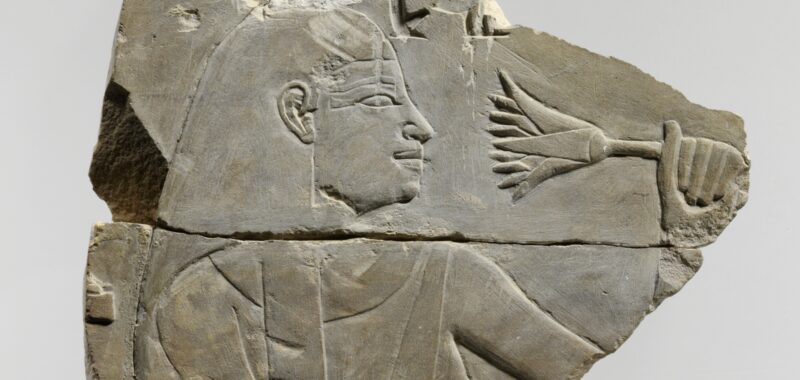What did ancient mummies smell like? What types of scents, perfumes, and odors proliferated in the embalming workshops of Ancient Egypt? Chemical analyses of artifacts by environmental historians, chemical engineers, and museum conservators are offering new insights into the scentscapes of antiquity, revealing the “woody,” “spicy,” and even “sweet” smells connected to Egyptian funerary practices. These emerging scientific studies are also helping both museum conservators and curators recreate the sensory environments of the past in new ways — reconnecting ancient art with the historical smells that used to emanate from them and allowing for more authentic heritage preservation.
Ancient art is most often displayed within sterile museum spaces that lack odor altogether. But this is usually not an accurate reflection of their original display or context. Fragrances played an important part in funerary rituals and in the performance of social status in Ancient Egypt in particular, in addition to being a part of everyday life. A new study in the Journal of the American Chemical Society underscores the ubiquity of pleasant smells attached to commonly displayed objects, like sarcophagi and wrappings used in mummified remains.
Published by researchers from the Heritage Science Laboratory in Ljubljana, Slovenia, and the Institute for Sustainable Heritage at University College London, the scientists examined nine mummies from the Egyptian Museum in Cairo in order to reconstruct their smell profiles. As the authors note, there is a cultural and scientific reason for reconstructing scents.
“The history of the past is often presented to the public as odorless, despite the value of smell for artifact interpretation,” they note. “Smells from heritage objects also hold a scientific value, as they can be used to obtain information about the original material, degradation pathways and rates, as well as conservation and restoration treatments and to better understand and interpret the heritage significance.”

Choosing to analyze the Cairo mummies was also important, the authors explained, because while similar analyses have been done on mummies in European collections, many of these specimens were treated with chemical agents for preservation and museum storage following excavation in the late 19th and early 20th centuries. European museums have also been known to spray heritage objects with contaminating pesticides. Cairo’s Egyptian Museum currently uses a “pest oil” made from natural oils to repel insects and corrosive elements.
Olfactory profiles can tell us a lot about the techniques used to preserve mummies in their own time as well. Combining chemical analysis of resins and residues with archaeological knowledge of Egyptian embalming practices also provides strong evidence for historical smellscapes.
Insight into the embalming techniques of Ancient Egyptians in particular has greatly developed in the past decade. In 2018, the Saqqara Saite Tombs Project at the University of Tübingen in Germany announced the discovery of an embalming workshop at the necropolis of Saqqara, offering an unprecedented first look into mummification processes and the commercial trade of funerary items such as funeral masks during the Saite-Persian period (664-525 BCE).
Inside the Saqqara complex, there was an embalmer’s cachette, a mummification workshop, and a connected shaft tomb for collective burials. Large basins, extensive ceramics, and vessels with embalming instructions filled the workshop. The basins appear to have had natron, a substance used to dry out the body prior to wrapping linen bandages around it. Scholar Ramadan Badry Hussein, who died in 2022, noted at the time of the discovery that the findings marked a new area in the “archaeology of mummification.” Nearly seven years later, researchers continue to uncover new and fragrant revelations about the smells attached to the process of mummification.

Unlike the museums of today, the ancient world was a melange of complex and meaningful smells. Whether it is an incense burner pulled from a Byzantine home or the patchouli wafting from a Roman perfume bottle, recreating ancient environments requires us to think about the multisensory context of objects and the people that made them. New archaeological discoveries coupled with advances in genetic and chemical analysis of residues are allowing for better conservation, preservation, and now the recreation of the signature scents of Ancient Egypt in particular. Such research is also seeping into the museum space.
In 2021, a recreation of the perfume of Cleopatra VII produced a spicy-sweet and musky fragrance with hints of fresh myrrh and cinnamon. It was published following an earlier multimedia exhibition of the perfume at the National Geographic Museum in Washington, DC. And in 2023, biomolecular analyses of the mummification balms from the Valley of the Kings revealed a mix of “beeswax, plant oil, fats, bitumen, Pinaceae resins, a balsamic substance, and dammar or Pistacia tree resin.”
Such advances in olfactory research led to the recent multisensory exhibition Perfumes of Ancient Egypt Through the Ages at the Egyptian Museum in Cairo. As these scientific recreations and multisensory museum approaches suggest, there is a growing recognition that smell is important to understanding the experience of antiquity. While not every museum gallery may soon be filled with the hints of myrrh, frankincense, or cinnamon, it is a good reminder that most ancient artifacts were never meant to exist in a scentless space.

